Bottom Flies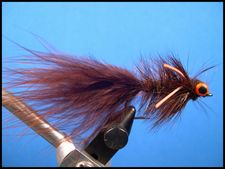 Holschlag Hackle FlyHere is how I tie the Holschlag Hackle Fly. Tim has just released his new book "Smallmouth Fly Fishing" which features the Hackle Fly along with thirty-nine other smallmouth flies. You can order the book from Tim at his new web site. Materials List
Tying NotesTim uses large brown chenille for the body of his fly. I use an underbody of Uni-Yarn dubbed with Hare-Tron Dubbin. I substitue Uni-Yarn and Hare-Tron Dubbin for the chenille for two reasons. Reason 1 - the Uni-Yarn can be applied to form a natural looking tapered body. The chenille can't. Reason 2 - the dubbed body can be brushed to marry the dubbing with the feather to make the fly buggier. Does it make the fly more effective. I doubt it. But remember, half of what we do at the vice is for the fish and the other half is for us. I think it makes the fly look better. So, that's why I do it. When tying the fly you can use from 1/50 to 1/24 oz. lead eyes depending upon how deep and where you are fishing it. Tim believes that barbell eyes painted either red or orange with black pupils are more attractive to fish than other eyes. Angling NotesUse a weight-forward fly line with an 8 to 10# test level leader material. The leader should be approximately two and one-half times longer than the depth of the water you are fishing. A strike indicator should be placed at the junction of the line and the leader. Watch the indicator for any slight movement and set the hook. In an interview with Dan Johnson for Midwest Fly Fishing Tim talked about the fly's design and how it should be fished. He told Dan that the fly is designed to be a bottom bouncer, imitating a crayfish in the current. It should be hopped along the bottom, fished with the current, until the line straightens out downstream. Make the fly hop with short snaps of the rod. Tying Instructions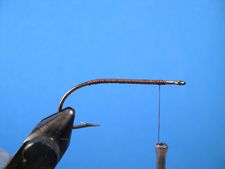 Step 1 Clamp the hook in the vice, crimp the barb with needle nose pliers, and attach the thread at the hook's eye. Wrap the thread to about 1/3rd of the way down the bend, reverse it, and make tight wraps of thread back to the hook's eye. 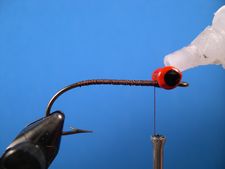 Step 2 Attach the barbell eyes slightly behind the hook's eye with several figure-eight wraps of thread. Apply a bit of Zap-A-Gap to lock in the eyes. Then make several more figure-eight wraps. Return the thread to a point opposite the hook barb in preparation for tying in the tail. 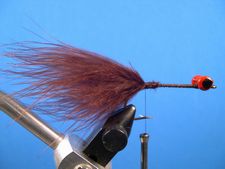 Step 3 Prepare a marabou plume by stroking back the fronds and removing about one and one-half inches of the tip. This eliminates part of the stem which makes the material more lively in the water. Measure the marabou against the hook to make a two-inch tail. Trim the butts and tie it in. 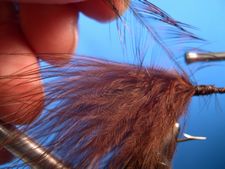 Step 4 Tie in a brown or brown grizzly Whitting Bugger Feather by it's tip with the cupped side facing the hook. Let the thread hang at the base of the feather. 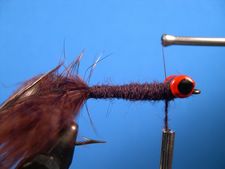 Step 5 Load the Uni-Yarn in a materials bobbin. Start the yarn directly behind the barbell eyes and take several figure-eight wraps of yarn over the eyes. Then build an underbody that tapers from the tail to the eyes as shown in the photo. If you didn't do this, you would have to use lots of dubbing to achieve the same effect. Once you have formed the tapered body let the yarn hang at the base of the eyes and spiral the tying thread to the eyes to tie off the yarn. Catch the yarn with the thread and take several thread wraps. Clip the yarn and spiral the thread back to the base of the hackle. 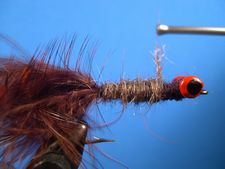 Step 6 Put a thin noodle of dubbing on the thread and dub over the tapered underbody. When you have finished the dubbing, leave the thread hanging at the base of the eyes. 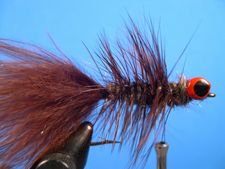 Step 7 Wrap the feather forward with fairly close wraps. In this photo you will notice that I had to tie off the feather about 80% of the way, and add another feather. You may have to do the same. Whether you add an additonal feather or not, the 80% point is the place where you tie in the legs. 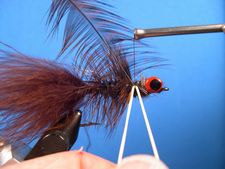 Step 8 Cut a five inch strand of yellow rubber into two equal strands. Fold and even the first strand around the thread, stretch it slightly, and tie the leg in on the near side of the hook with three of four wraps of thread. Fold and even the second strand, stetch it slightly, and tie it in on the far side of the hook with three or four turns of thread. Move the thread to the base of the eyes and let it hang. 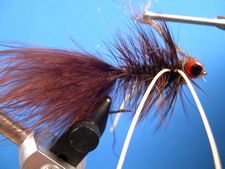 Step 9 Wrap the second feather behind, between, and in front of the legs and then on to the head where you should make a couple of close wraps just before the eyes. Tie off the feather and remove the excess. Add some more dubbing to the thread and dub around the eyes with several figure-eight wraps of dubbing until you build a visible head around the eyes. Move the thread to the front of the eyes, build up a thread head between the hook's eye and the barbell eyes. Tie off the thread with two half-hitches. 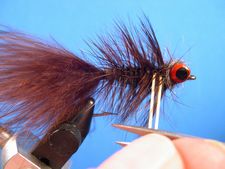 Step 10 You want the legs to move in the water so trim them to a length of one-quarter inches. 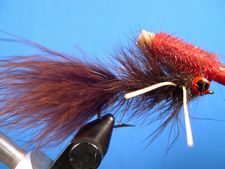 Step 11 Brush the fly vigorously with a Dubbing Brush to marry the dubbing with the feather. Check out the Tier's Bench to learn how to make Dave Whitlock's Dubbing Brush. 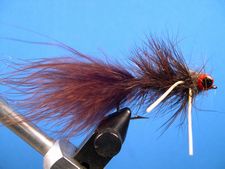 Step 12 Your Holschlag Hackle Fly is finished. Go fish it. I hope that you have as much success with it as Tim Holschlag does.
Warmwater Fly Tyer - by Ward Bean
© Copyright 2026 Ward Bean, Council Bluffs, IA, All rights reserved. © Copyright 2026 Ward Bean, Council Bluffs, IA, All rights reserved.
|